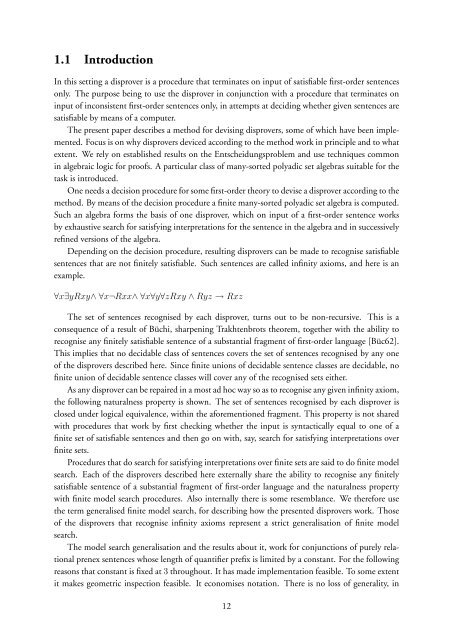On the methods of mechanical non-theorems (latest version)
On the methods of mechanical non-theorems (latest version)
On the methods of mechanical non-theorems (latest version)
Create successful ePaper yourself
Turn your PDF publications into a flip-book with our unique Google optimized e-Paper software.
1.1 Introduction<br />
In this setting a disprover is a procedure that terminates on input <strong>of</strong> satisfiable first-order sentences<br />
only. The purpose being to use <strong>the</strong> disprover in conjunction with a procedure that terminates on<br />
input <strong>of</strong> inconsistent first-order sentences only, in attempts at deciding whe<strong>the</strong>r given sentences are<br />
satisfiable by means <strong>of</strong> a computer.<br />
The present paper describes a method for devising disprovers, some <strong>of</strong> which have been implemented.<br />
Focus is on why disprovers deviced according to <strong>the</strong> method work in principle and to what<br />
extent. We rely on established results on <strong>the</strong> Entscheidungsproblem and use techniques common<br />
in algebraic logic for pro<strong>of</strong>s. A particular class <strong>of</strong> many-sorted polyadic set algebras suitable for <strong>the</strong><br />
task is introduced.<br />
<strong>On</strong>e needs a decision procedure for some first-order <strong>the</strong>ory to devise a disprover according to <strong>the</strong><br />
method. By means <strong>of</strong> <strong>the</strong> decision procedure a finite many-sorted polyadic set algebra is computed.<br />
Such an algebra forms <strong>the</strong> basis <strong>of</strong> one disprover, which on input <strong>of</strong> a first-order sentence works<br />
by exhaustive search for satisfying interpretations for <strong>the</strong> sentence in <strong>the</strong> algebra and in successively<br />
refined <strong>version</strong>s <strong>of</strong> <strong>the</strong> algebra.<br />
Depending on <strong>the</strong> decision procedure, resulting disprovers can be made to recognise satisfiable<br />
sentences that are not finitely satisfiable. Such sentences are called infinity axioms, and here is an<br />
example.<br />
∀x∃yRxy∧ ∀x¬Rxx∧ ∀x∀y∀zRxy ∧ Ryz → Rxz<br />
The set <strong>of</strong> sentences recognised by each disprover, turns out to be <strong>non</strong>-recursive. This is a<br />
consequence <strong>of</strong> a result <strong>of</strong> Büchi, sharpening Trakhtenbrots <strong>the</strong>orem, toge<strong>the</strong>r with <strong>the</strong> ability to<br />
recognise any finitely satisfiable sentence <strong>of</strong> a substantial fragment <strong>of</strong> first-order language [Büc62].<br />
This implies that no decidable class <strong>of</strong> sentences covers <strong>the</strong> set <strong>of</strong> sentences recognised by any one<br />
<strong>of</strong> <strong>the</strong> disprovers described here. Since finite unions <strong>of</strong> decidable sentence classes are decidable, no<br />
finite union <strong>of</strong> decidable sentence classes will cover any <strong>of</strong> <strong>the</strong> recognised sets ei<strong>the</strong>r.<br />
As any disprover can be repaired in a most ad hoc way so as to recognise any given infinity axiom,<br />
<strong>the</strong> following naturalness property is shown. The set <strong>of</strong> sentences recognised by each disprover is<br />
closed under logical equivalence, within <strong>the</strong> aforementioned fragment. This property is not shared<br />
with procedures that work by first checking whe<strong>the</strong>r <strong>the</strong> input is syntactically equal to one <strong>of</strong> a<br />
finite set <strong>of</strong> satisfiable sentences and <strong>the</strong>n go on with, say, search for satisfying interpretations over<br />
finite sets.<br />
Procedures that do search for satisfying interpretations over finite sets are said to do finite model<br />
search. Each <strong>of</strong> <strong>the</strong> disprovers described here externally share <strong>the</strong> ability to recognise any finitely<br />
satisfiable sentence <strong>of</strong> a substantial fragment <strong>of</strong> first-order language and <strong>the</strong> naturalness property<br />
with finite model search procedures. Also internally <strong>the</strong>re is some resemblance. We <strong>the</strong>refore use<br />
<strong>the</strong> term generalised finite model search, for describing how <strong>the</strong> presented disprovers work. Those<br />
<strong>of</strong> <strong>the</strong> disprovers that recognise infinity axioms represent a strict generalisation <strong>of</strong> finite model<br />
search.<br />
The model search generalisation and <strong>the</strong> results about it, work for conjunctions <strong>of</strong> purely relational<br />
prenex sentences whose length <strong>of</strong> quantifier prefix is limited by a constant. For <strong>the</strong> following<br />
reasons that constant is fixed at 3 throughout. It has made implementation feasible. To some extent<br />
it makes geometric inspection feasible. It economises notation. There is no loss <strong>of</strong> generality, in<br />
12
















